SCDS214F October 2005 – December 2021 TS5A3359
PRODUCTION DATA
- 1 Features
- 2 Applications
- 3 Description
- 4 Revision History
- 5 Pin Configuration and Functions
-
6 Specifications
- 6.1 Absolute Maximum Ratings
- 6.2 ESD Ratings
- 6.3 Recommended Operating Conditions
- 6.4 Thermal Information
- 6.5 Electrical Characteristics for 5-V Supply
- 6.6 Electrical Characteristics for 3.3-V Supply
- 6.7 Electrical Characteristics for 2.5-V Supply
- 6.8 Electrical Characteristics for 1.8-V Supply
- 6.9 Typical Characteristics
- 7 Parameter Measurement Information
- 8 Detailed Description
- 9 Application and Implementation
- 10Power Supply Recommendations
- 11Layout
- 12Device and Documentation Support
- 13Mechanical, Packaging, and Orderable Information
Package Options
Mechanical Data (Package|Pins)
Thermal pad, mechanical data (Package|Pins)
Orderable Information
7 Parameter Measurement Information
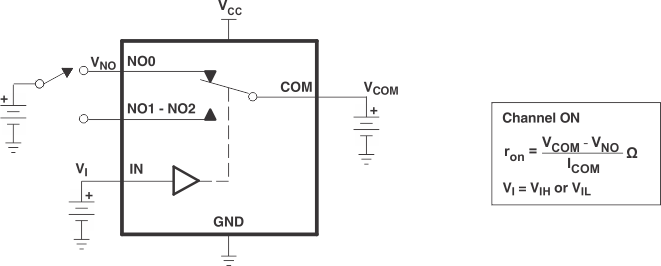 Figure 7-1 ON-State
Resistance (Ron)
Figure 7-1 ON-State
Resistance (Ron)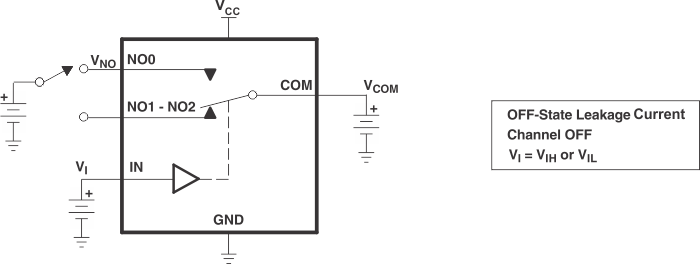 Figure 7-2 OFF-State
Leakage Current (INC(OFF), INO(OFF),
INO(PWROFF), ICOM(OFF),
ICOM(PWROFF))
Figure 7-2 OFF-State
Leakage Current (INC(OFF), INO(OFF),
INO(PWROFF), ICOM(OFF),
ICOM(PWROFF))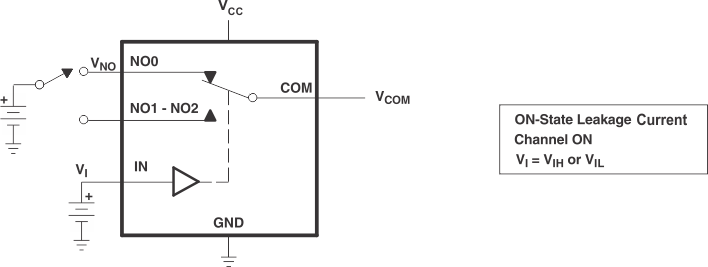 Figure 7-3 ON-State
Leakage Current (ICOM(ON), INO(ON))
Figure 7-3 ON-State
Leakage Current (ICOM(ON), INO(ON))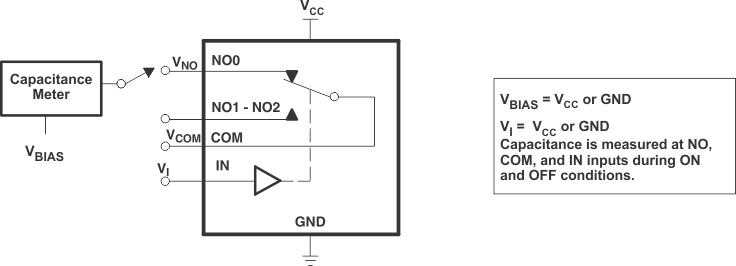 Figure 7-4 Capacitance (CI, CCOM(ON), CNO(OFF),
CCOM(OFF), CNO(ON))
Figure 7-4 Capacitance (CI, CCOM(ON), CNO(OFF),
CCOM(OFF), CNO(ON))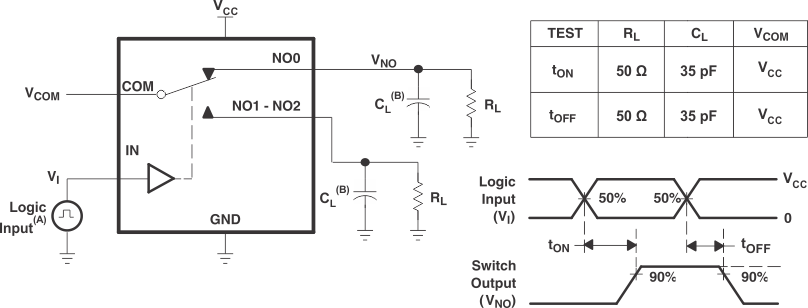
All input pulses are supplied
by generators having the following characteristics: PRR ≤ 10 MHz, ZO = 50 Ω,
tr < 5 ns, tf < 5 ns.
CL includes probe
and jig capacitance.
Figure 7-5 Turnon
(tON) and Turnoff Time (tOFF)
All input pulses are supplied
by generators having the following characteristics: PRR ≤ 10 MHz, ZO = 50 Ω,
tr < 5 ns, tf < 5 ns.
CL includes probe
and jig capacitance.
Figure 7-6 Break-Before-Make Time (tBBM)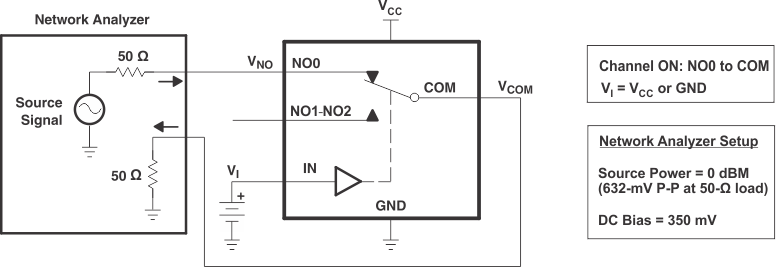 Figure 7-7 Bandwidth
(BW)
Figure 7-7 Bandwidth
(BW)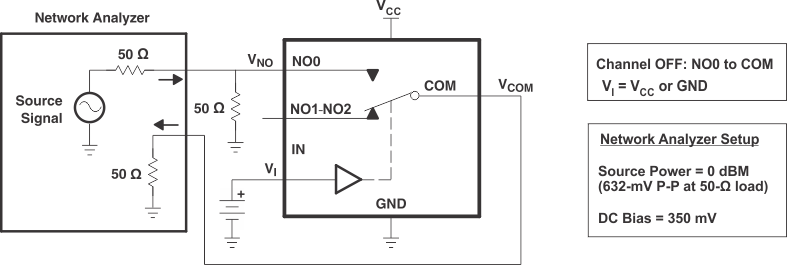 Figure 7-8 Off
Isolation (OISO)
Figure 7-8 Off
Isolation (OISO)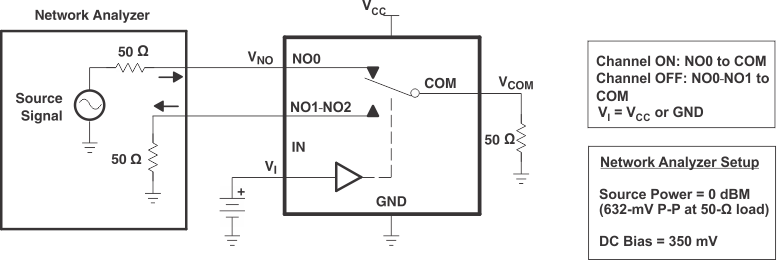 Figure 7-9 Crosstalk
(XTALK)
Figure 7-9 Crosstalk
(XTALK)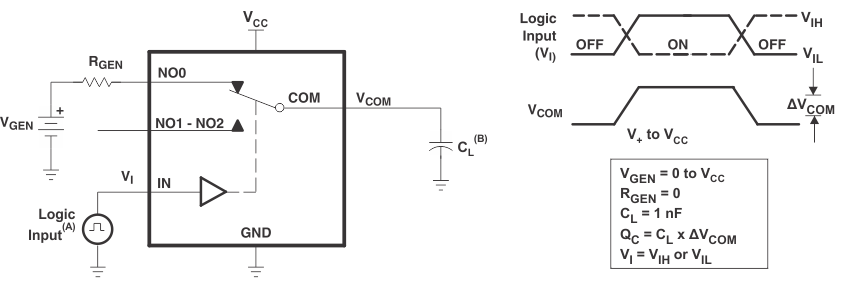
All input pulses are supplied
by generators having the following characteristics: PRR ≤ 10 MHz, ZO = 50 Ω,
tr < 5 ns, tf < 5 ns.
CL includes probe
and jig capacitance.
Figure 7-10 Charge
Injection (QC)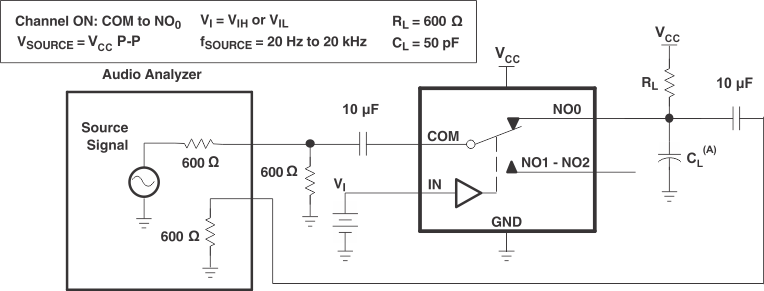
CL includes probe
and jig capacitance.
Figure 7-11 Total
Harmonic Distortion (THD)Table 7-1 Parameter Description
| SYMBOL | DESCRIPTION |
|---|---|
| VCOM | Voltage at COM |
| VNO | Voltage at NO |
| ron | Resistance between COM and NC or COM and NO ports when the channel is ON |
| rpeak | Peak ON-state resistance over a specified voltage range |
| Δron | Difference of ron between channels in a specific device |
| ron(flat) | Difference between the maximum and minimum value of ron in a channel over the specified range of conditions |
| INO(OFF) | Leakage current measured at the NO port, with the corresponding channel (NO to COM) in the OFF state |
| INO(PWROFF) | Leakage current measured at the NO port during the power-down condition, VCC = 0. |
| INO(ON) | Leakage current measured at the NO port, with the corresponding channel (NO to COM) in the ON state and the output (COM) open |
| ICOM(ON) | Leakage current measured at the COM port, with the corresponding channel (COM to NO or COM to NC) in the ON state and the output (NC or NO) open |
| ICOM(OFF) | Leakage current measured at the COM port during the power-down condition, VCC = 0 |
| ICOM(PWROFF) | Leakage current measured at the COM port during the power-down condition, VCC = 0. |
| VIH | Minimum input voltage for logic high for the control input (IN) |
| VIL | Maximum input voltage for logic low for the control input (IN) |
| VI | Voltage at the control input (IN) |
| IIH, IIL | Leakage current measured at the control input (IN) |
| tON | Turnon time for the switch. This parameter is measured under the specified range of conditions and by the propagation delay between the digital control (IN) signal and analog output (COM or NO) signal when the switch is turning ON. |
| tOFF | Turnoff time for the switch. This parameter is measured under the specified range of conditions and by the propagation delay between the digital control (IN) signal and analog output (COM or NO) signal when the switch is turning OFF. |
| tBBM | Break-before-make time. This parameter is measured under the specified range of conditions and by the propagation delay between the output of two adjacent analog channels (NC and NO) when the control signal changes state. |
| QC | Charge injection is a measurement of unwanted signal coupling from the control (IN) input to the analog (NO or COM) output. This is measured in coulomb (C) and measured by the total charge induced due to switching of the control input.Charge injection, QC = CL × ΔVCOM, CL is the load capacitance and ΔVCOM is the change in analog output voltage. |
| CNO(OFF) | Capacitance at the NO port when the corresponding channel (NO to COM) is OFF |
| CNO(ON) | Capacitance at the NO port when the corresponding channel (NO to COM) is ON |
| CCOM(ON) | Capacitance at the COM port when the corresponding channel (COM to NO) is ON |
| CCOM(OFF) | Capacitance at the COM port when the corresponding channel (COM to NO) is OFF |
| CI | Capacitance of control input (IN) |
| OISO | OFF isolation of the switch is a measurement of OFF-state switch impedance. This is measured in dB in a specific frequency, with the corresponding channel (NC to COM or NO to COM) in the OFF state. |
| XTALK | Crosstalk is a measurement of unwanted signal coupling from an ON channel to an OFF channel (NC to NO or NO to NC). This is measured in a specific frequency and in dB. |
| BW | Bandwidth of the switch. This is the frequency in which the gain of an ON channel is –3 dB less than the DC gain. |
| THD | Total harmonic distortion describes the signal distortion caused by the analog switch. This is defined as the ratio of root mean square (RMS) value of the second, third, and higher harmonic to the absolute magnitude of the fundamental harmonic. |
| ICC | Static power-supply current with the control (IN) pin at VCC or GND |
Table 7-2 Summary of
Characteristics(1)
| PARAMETER | CHARACTERISTIC |
|---|---|
| Configuration | Triple 3:1 Multiplexer/ Demultiplexer (1 × SP3T) |
| Number of channels | 1 |
| ON-state resistance (ron) | 1.1 Ω |
| ON-state resistance match (Δron) | 0.1 Ω |
| ON-state resistance flatness (ron(flat)) | 0.15 Ω |
| Turnon/turnoff time (tON/tOFF) | 40 ns/35 ns |
| Break-before-make time (tBBM) | 1 ns |
| Charge injection (QC) | 40 pC |
| Bandwidth (BW) | 100 MHz |
| OFF isolation (OISO) | –65 dB at 10 MHz |
| Crosstalk (XTALK) | –66 dB at 10 MHz |
| Total harmonic distortion (THD) | 0.01% |
| Leakage current (ICOM(OFF)/INO(OFF)) | ±20 μA |
| Power supply current (ICC) | 0.1 μA |
| Package options | 8-pin DCU or YZP |
(1) VCC = 5 V, TA = 25°C